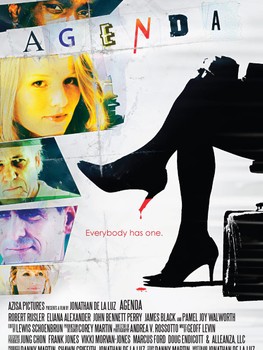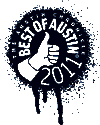Austin Filmmaker's 'Agenda' Attempts to Channel Classic Noir
 By Amanda Natiello
By Amanda Natiello
When I heard about last month's screening of Agenda, a film meant to "pay homage to another era of storytelling, the film noir genre," I was thrilled. Film noir offers so much for consideration: the aesthetics, the complex plot structures, hard-boiled detective characters and the debate about what makes a film noir. I see noir as both an aesthetic and a narrative style that evokes a certain era of movies, specifically the period immediately following World War II, and a specific genre of film, usually of the mystery or detective varieties.
In channeling what I knew of film noir and what I had read in James M. Cain's novels, I began to play detective, listening to conversations as patrons trickled in, and piecing together what information I could gather about filmmaker Jonathan de la Luz in the cocktail hour before the screening. He had at least one friend in the audience, a man working the room who, like the rest of us, did not know much about the director's works. The audience, from what I gathered, also did not know much about film noir.
That is not to say that the director does not know his noir; rather, he knows it too well, but employs his knowledge on a shallow level. The film description reads, "Agenda is the story of a young man who comes into the life of a married couple and wreaks havoc." That sums up the movie in a nutshell, and immediately reminded me of the plot to The Postman Always Rings Twice and as one audience member reminded me, Body Heat. The basic plot structure was the first indication of de la Luz's source material.
The opening shot of Agenda featured a close-up of a pair of shapely ankles and high-heeled shoes. I hoped that someone else in the theater would see the parallels to the famous anklet shot of Barbara Stanwyck in Double Indemnity. While this allusion proved a plot twist of sorts, offering the first glimpse of the feature's only dynamic character, the other allusions in this film — there were far too many to mention here — either directly ripped from or poorly imitated films of the classic era. It felt as if de la Luz were putting on a version of The Complete Works of Film Noir: Abridged. Everything, even the commentary from some members of the audience that I had overheard, was wrong, and nothing worked, not even the projector.
I did feel for the director, who attended the screening, as he watched the projector interrupt his work repeatedly, which made for an unpleasant viewing experience and lost the audience in the midst of the twist. This was, in my opinion, just one in a series of hiccups in the evening, and the man who put in so much time and energy into seeing his work on the big screen for the first time was there to see each malfunction.
Where de la Luz failed with Agenda was not in his lack of trying, but rather in his trying too hard to make a noir story; however, he failed to evoke the noir feeling and aesthetic, which, to many people, are what make a film noir. However, black and white does not a noir film make. Were he to have utilized his source material better, and brought a second copy of the film, de la Luz would have had a successful screening. Alas, in my opinion, this was not the case.
Amanda Natiello is an intern with the Austin Film Society.

